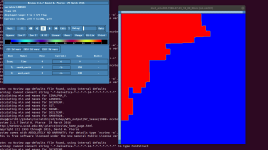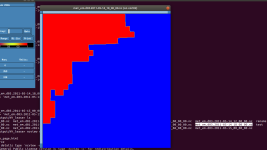Hello,
There seems to be sparse information on formal step-by-step instructions for processing ERA5 data in WPS, which is a problem when issues are encountered. I have used ERA5 in WPS, so am aware of the steps required. I have not, however, used ERA5 without some form of external SST data - and this is where I am having some issues due to the masking from ERA5 being retained (as opposed to specific masking being used from SST datasets).
Without separate SST data, I was seeing problems with the output of the SST field in metgrid, identical to that described here: https://forum.mmm.ucar.edu/phpBB3/viewtopic.php?t=8964
I have since fixed the SST field by changing the METGRID.TBL file to read:
name=SST
interp_option=wt_average_16pt
fill_missing=0.
missing_value=-1.E30
flag_in_output=FLAG_SST
interp_mask = LANDSEA(1)
masked=land
But the issue remains for SKINTEMP in the metgrid files.
This is the resulting LANDSEA mask:

And this is what SKINTEMP looks like as a result of that mask:

My WRF input and output looks OK for the variables I am outputting (including T2 etc.). When I check the restart files, T2, TSK etc. all look fine, but I want to make sure I am following best practices, as I am not convinced metgrid is giving me the right result due to the masking.
I have attempted to follow the instructions given here for using the static data:
https://forum.mmm.ucar.edu/phpBB3/viewtopic.php?f=75&t=9714&p=19000&hilit=ERA5#p19000
http://climate-cms.wikis.unsw.edu.au/How_to_run_WRF_with_ERA-Interim_data
But, I am getting an error in metgrid (see below).
The ERA5 static data file I am using is:
e5.oper.invariant.128_172_lsm.ll025sc.1979010100_1979010100.grb
Steps:
1. I run ungrib for ERA5 *.pl and *.sl data (=FILE in namelist.wps) using Vtable.ERA-interim.pl (this is for the specific meteorological dates)
2. I then run ungrib for the e5.oper.invariant.* file above (=INV* namelist.wps) for the specific fixed date 1979/01/01 00:00:00, using the following Vtable information:
GRIB | Level| Level| Level| metgrid | metgrid | metgrid |
Code | Code | 1 | 2 | Name | Units | Description |
-----+------+------+------+----------+---------+-----------------------------------------+
172 | 1 | 0 | | LANDSEA | 0/1 Flag| Land/Sea flag |
-----+------+------+------+----------+---------+-----------------------------------------+
3. I then run metgrid for the specific meteorological dates using the following addition to &metgrid:
&metgrid
fg_name = 'FILE',
io_form_metgrid = 2,
constants_name = 'INV:1979-01-01_00'
But, as indicated, the following error occurs when running metgrid:
Processing domain 1 of 3
INV:1979-01-01_00
Processing 1988-07-03_18
FILE
ERROR: Cannot combine time-independent data with time-dependent data for field LANDSEA.mask
I would hope someone out there has encountered this and has a solution. Also, I hope someone can clarify the steps for running WPS with ERA5 static data (in case I am wrong in my approach), because the forum posts I have mentioned above don't outline the steps involved for using the static data.
Thank you!
Tristan
There seems to be sparse information on formal step-by-step instructions for processing ERA5 data in WPS, which is a problem when issues are encountered. I have used ERA5 in WPS, so am aware of the steps required. I have not, however, used ERA5 without some form of external SST data - and this is where I am having some issues due to the masking from ERA5 being retained (as opposed to specific masking being used from SST datasets).
Without separate SST data, I was seeing problems with the output of the SST field in metgrid, identical to that described here: https://forum.mmm.ucar.edu/phpBB3/viewtopic.php?t=8964
I have since fixed the SST field by changing the METGRID.TBL file to read:
name=SST
interp_option=wt_average_16pt
fill_missing=0.
missing_value=-1.E30
flag_in_output=FLAG_SST
interp_mask = LANDSEA(1)
masked=land
But the issue remains for SKINTEMP in the metgrid files.
This is the resulting LANDSEA mask:

And this is what SKINTEMP looks like as a result of that mask:

My WRF input and output looks OK for the variables I am outputting (including T2 etc.). When I check the restart files, T2, TSK etc. all look fine, but I want to make sure I am following best practices, as I am not convinced metgrid is giving me the right result due to the masking.
I have attempted to follow the instructions given here for using the static data:
https://forum.mmm.ucar.edu/phpBB3/viewtopic.php?f=75&t=9714&p=19000&hilit=ERA5#p19000
http://climate-cms.wikis.unsw.edu.au/How_to_run_WRF_with_ERA-Interim_data
But, I am getting an error in metgrid (see below).
The ERA5 static data file I am using is:
e5.oper.invariant.128_172_lsm.ll025sc.1979010100_1979010100.grb
Steps:
1. I run ungrib for ERA5 *.pl and *.sl data (=FILE in namelist.wps) using Vtable.ERA-interim.pl (this is for the specific meteorological dates)
2. I then run ungrib for the e5.oper.invariant.* file above (=INV* namelist.wps) for the specific fixed date 1979/01/01 00:00:00, using the following Vtable information:
GRIB | Level| Level| Level| metgrid | metgrid | metgrid |
Code | Code | 1 | 2 | Name | Units | Description |
-----+------+------+------+----------+---------+-----------------------------------------+
172 | 1 | 0 | | LANDSEA | 0/1 Flag| Land/Sea flag |
-----+------+------+------+----------+---------+-----------------------------------------+
3. I then run metgrid for the specific meteorological dates using the following addition to &metgrid:
&metgrid
fg_name = 'FILE',
io_form_metgrid = 2,
constants_name = 'INV:1979-01-01_00'
But, as indicated, the following error occurs when running metgrid:
Processing domain 1 of 3
INV:1979-01-01_00
Processing 1988-07-03_18
FILE
ERROR: Cannot combine time-independent data with time-dependent data for field LANDSEA.mask
I would hope someone out there has encountered this and has a solution. Also, I hope someone can clarify the steps for running WPS with ERA5 static data (in case I am wrong in my approach), because the forum posts I have mentioned above don't outline the steps involved for using the static data.
Thank you!
Tristan



